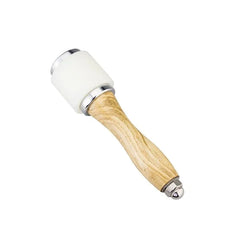Using Mallets and Mauls for Leathercraft
Antonia MarinoWhen starting out in leathercraft, having the right tools makes all the difference. Two essential tools you'll come across are mauls and mallets. While they may look similar, they serve different purposes. Let’s break it down so you can choose the right one for your project

What is a Maul?
Most mauls have a cylindrical head made of rawhide or poly, ensuring durability and consistent strikes. A maul is a weighted hammer, typically ranging from 16 to 32 ounces, but some can go beyond 70 ounces. The weight helps apply force for tasks like stamping, setting rivets, and pounding seams.
Which Weight Should You Choose?
- 16 oz. – Ideal for detailed work, like tooling and stamping.
- 24 oz. – A great all-rounder, balancing power and control.
- 1.5 - 2 lbs. – Provides more power and precision.
- 32 oz. - 3 lbs. – Best for heavy-duty tasks like punching strap ends.
How to Use a Maul:
- Hold it firmly but not too tightly to maintain control
- Strike on the curved part of the head.
- With practice, mauls offer better accuracy compared to mallets.
What is a Mallet?

A mallet has a softer striking surface, making it perfect for delicate tasks or when working with softer leather. Unlike a maul, you strike with the flat end of the head. Mallets come in various materials, including rawhide, rubber, bakelite, poly, wood, and plastic.
Rawhide Mallets
- Great for tooling, embossing, and shaping leather.
- A lightweight (8-16 oz.) mallet offers better precision and control.
- Heavier rawhide mallets are useful for setting copper or tubular rivets.
Poly Mallets
- Affordable and durable.
- A 9 oz. poly mallet is excellent for beginners rivet setting, stamping, and tooling.
- Heavier versions add extra force for tougher jobs.

